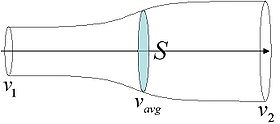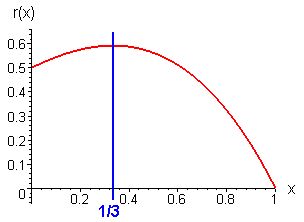
Betz' law
Encyclopedia

Albert Betz
Albert Betz was a German physicist and a pioneer of wind turbine technology.In 1910 he graduated as a naval engineer from Technische Hochschule Berlin...
. According to Betz's law, no turbine can capture more than 59.3 percent of the kinetic energy in wind.
The ideal or maximum theoretical efficiency n max (also called power coefficient) of a wind turbine is the ratio of maximum power obtained from the wind to the total power available in the wind. The factor 0.593 is known as Betz's coefficient. It is the maximum fraction of the power in a wind stream that can be extracted.
power coefficient = Cp =( power output from wind machine) / (power available in wind )
A simple explanation
The Betz law means that wind turbines can never be better than 59.3% efficient. The law can be simply explained by considering that if all of the energy coming from wind movement into the turbine were converted into useful energy then the wind speed afterwards would be zero. But, if the wind stopped moving at the exit of the turbine, then no more fresh wind could get in - it would be blocked. In order to keep the wind moving through the turbine, to keep getting energy, there has to be some wind movement on the outside with energy left in it. There must be a 'sweet spot' somewhere - and there is, the Betz limit at 59.3%Three independent discoveries of the turbine efficiency limit
The British scientist Lanchester derived the same maximum already in 1915. The leader of the Russian aerodynamic school, Zhukowsky, also published the same result for an ideal wind turbine in 1920, the same year as Betz did. It is thus an example of Stigler's Law.Economic relevance
Because some modern wind turbines approach this potential maximum efficiency, once practical engineering obstacles are considered, Betz' Law shows a limiting factor for this form of renewable energy. Engineering constraints, energy storage and transmission losses and other factors mean that even the best modern turbines may operate at efficiencies substantially below the Betz Limit.Proof
It shows the maximum possible energy — known as the Betz limit — that may be derived by means of an infinitely thin rotor from a fluid flowing at a certain speed.In order to calculate the maximum theoretical efficiency of a thin rotor (of, for example, a windmill
Windmill
A windmill is a machine which converts the energy of wind into rotational energy by means of vanes called sails or blades. Originally windmills were developed for milling grain for food production. In the course of history the windmill was adapted to many other industrial uses. An important...
) one imagines it to be replaced by a disc that withdraws energy from the fluid passing through it. At a certain distance behind this disc the fluid that has passed through flows with a reduced velocity.
Assumptions
1. The rotor does not possess a hub, this is an ideal rotor, with an infinite number of blades which have no drag. Any resulting drag would only lower this idealized value.2. The flow into and out of the rotor is axial. This is a control volume analysis, and to construct a solution the control volume must contain all flow going in and out, failure to account for that flow would violate the conservation equations.
3. This is incompressible flow. The density remains constant, and there is no heat transfer from the rotor to the flow or vice versa.
4. The rotor is also massless. No account is taken of angular momentum imparted to either the rotor or the air flow behind the rotor, i.e., no account is taken of any wake effect..
Application of conservation of mass (continuity equation)
Applying conservation of mass to this control volume, the mass flow rateMass flow rate
Mass flow rate is the mass of substance which passes through a given surface per unit time. Its unit is mass divided by time, so kilogram per second in SI units, and slug per second or pound per second in US customary units...
(the mass of fluid flowing per unit time) is given by:
where v1 is the speed in the front of the rotor and v2 is the speed downstream of the rotor, and v is the speed at the fluid power device. ρ is the fluid density, and the area of the turbine is given by S. The force exerted on the wind by the rotor may be written as
-

Power and work
The work donePower (physics)In physics, power is the rate at which energy is transferred, used, or transformed. For example, the rate at which a light bulb transforms electrical energy into heat and light is measured in watts—the more wattage, the more power, or equivalently the more electrical energy is used per unit...
by the force may be written incrementally as
and the power (rate of work done) of the wind is
Now substituting the force F computed above into the power equation will yield the power extracted from the wind:
However, power can be computed another way, by using the kinetic energy. Applying the conservation of energy equation to the control volume yields
Looking back at the continuity equation, a substitution for the mass flow rate yields the following
Both of these expressions for power are completely valid, one was derived by examining the incremental work done and the other by the conservation of energy. Equating these two expressions yields
Examining the two equated expressions yields an interesting result, mainly
or
Therefore, the wind velocity at the rotor may be taken as the average of the upstream and downstream velocities. This is often the most argued against portion of Betz' law, but as it can be seen from the above derivation, it is indeed correct.
Betz' law and coefficient of performance
Returning to the previous expression for powerPower (physics)In physics, power is the rate at which energy is transferred, used, or transformed. For example, the rate at which a light bulb transforms electrical energy into heat and light is measured in watts—the more wattage, the more power, or equivalently the more electrical energy is used per unit...
based on kinetic energy:
-
-
 .
.
-
By differentiating DerivativeIn calculus, a branch of mathematics, the derivative is a measure of how a function changes as its input changes. Loosely speaking, a derivative can be thought of as how much one quantity is changing in response to changes in some other quantity; for example, the derivative of the position of a...
DerivativeIn calculus, a branch of mathematics, the derivative is a measure of how a function changes as its input changes. Loosely speaking, a derivative can be thought of as how much one quantity is changing in response to changes in some other quantity; for example, the derivative of the position of a...
(through careful application of the chain ruleChain ruleIn calculus, the chain rule is a formula for computing the derivative of the composition of two or more functions. That is, if f is a function and g is a function, then the chain rule expresses the derivative of the composite function in terms of the derivatives of f and g.In integration, the...
) with respect to
with respect to  for a given fluid speed v1 and a given area S one finds the maximum or minimum value for
for a given fluid speed v1 and a given area S one finds the maximum or minimum value for  . The result is that
. The result is that  reaches maximum value when
reaches maximum value when  .
.
Substituting this value results in:
-
 .
.
The work rate obtainable from a cylinder of fluid with cross sectional area S and velocity v1 is:
-
 .
.
The "power coefficient" Cp (= P/Pwind) has a maximum value of: Cp.max = 16/27 = 0.593 (or 59.3%; however, coefficients of performance are usually expressed as a decimal, not a percentage).
Rotor losses are the most significant energy losses in, for example, a wind mill. It is, therefore, important to reduce these as much as possible. Modern rotors achieve values for Cp in the range of 0.4 to 0.5, which is 70 to 80% of the theoretically possible maximum.
Points of interest
Note that the preceding analysis has no dependence on the geometry, therefore S may take any form provided that the flow travels axially from the entrance to the control volume to the exit, and the control volume has uniform entry and exit velocities. Note that any extraneous effects can only decrease the performance of the turbine since this analysis was idealized to disregard friction. Any non-ideal effects would detract from the energy available in the incoming fluid, lowering the overall efficiencies.
There have been several arguments made about this limit and the effects of nozzles, and there is a distinct difficulty when considering power devices that use more captured area than the area of the rotor. Some manufacturers and inventors have made claims of exceeding the Betz' limit by doing just this; in reality, their initial assumptions are wrong, since they are using a substantially larger than the size of their rotor, and this skews their efficiency number. In reality, the rotor is just as efficient as it would be without the nozzle or capture device, but by adding such a device you make more power available in the upstream wind from the rotor.
than the size of their rotor, and this skews their efficiency number. In reality, the rotor is just as efficient as it would be without the nozzle or capture device, but by adding such a device you make more power available in the upstream wind from the rotor.
Observation: If we use the middle following (harmonic mean) of the speeds

To take the place of ,
,
then if then
then  for whatever value of
for whatever value of  (impact without motion).
(impact without motion).
The calculation is very simple and gives a 50% output.
Modern development
In 1935 H. GlauertHermann GlauertHermann Glauert, FRS was a British aerodynamicist and Principal Scientific Officer of the Royal Aircraft Establishment, Farnborough until December 1934....
derived the expression for turbine efficiency, when the angular component of velocity is taken into account, by applying an energy balance across the rotor plane. Due to the Glauert model, efficiency is below the Betz limit, and asymptotically approaches this limit when the tip speed ratio goes to infinity.
In 2001, Gorban, Gorlov and Silantyev introduced an exactly solvable model (GGS), that considers non-uniform pressure distribution and curvilinear flow across the turbine plane (issues not included in the Betz approach). The GGS model predicts that peak efficiency is achieved when the flow through the turbine is approximately 61% which is very similar to the Betz result of 2/3, but the GGS predicted peak efficiency is much smaller: 30.1%.
Recently, viscous computations based on computational fluid dynamicsComputational fluid dynamicsComputational fluid dynamics, usually abbreviated as CFD, is a branch of fluid mechanics that uses numerical methods and algorithms to solve and analyze problems that involve fluid flows. Computers are used to perform the calculations required to simulate the interaction of liquids and gases with...
(CFD) were applied to wind turbine modelling and demonstrated satisfactory agreement with experiment. Computed optimal efficiency is, typically, between the Betz limit and the GGS solution. -














